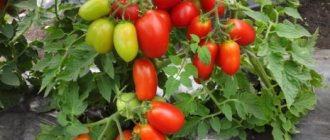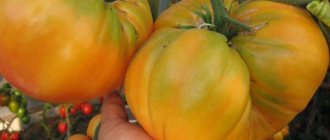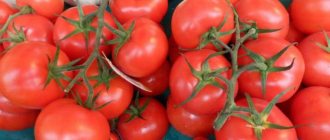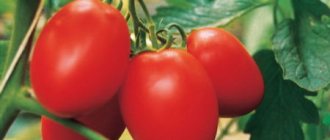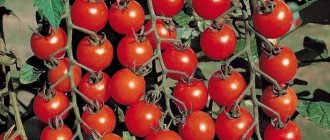Description of Niagara tomato variety
Tomato Niagara has an indeterminate growth type. The height of the bush is 1.5-1.8 m. The root system of the plant is strong, but the stem is thin, so it is necessary to grow it on a support in the form of stakes or with a garter to a trellis.
Despite the waterfall of fruits, Niagara forms a compact bush
The manufacturer recommends growing Niagara tomato with 1-2 stems, but according to reviews from gardeners, the crop develops well and bears fruit with a more branched formation - 3-4 stems. The leaves are medium sized and green. The inflorescences are simple.
Important! When growing Niagara tomatoes, it is necessary to apply an increased amount of fertilizing.
The variety is intended for growing indoors, but also performs well in open beds with a protective film in case of bad weather and cold snaps. It is distinguished by good fruit set, including at various temperature deviations. Fruiting is abundant, extended, and occurs from July to August.
Description of fruits
The fruits have a beautiful elongated shape, like cream with a spout. The average weight is about 95 g. The size of one tomato can reach 120 g if the amount of ovary is rationed and formed into one stem. Multiple clusters - from 10 to 14 tomatoes each. Unripe tomatoes are green in color, while ripe ones are red. The pulp is fleshy, with few seeds.
The taste of tomatoes is delicate, the characteristic sourness is almost not felt
The fruits are decorative and aligned throughout the bush. The surface is smooth, the skin is dense, and there are 2-3 seed chambers inside. Tomatoes tend to fall off the hand even from a light touch, but are not damaged.
The dense, non-watery fruits withstand long-term storage well, during which they may only dry out somewhat. They tolerate transportation well.
Characteristics of Niagara tomato variety
The Niagara tomato is a variety produced in Siberia, taking into account the climate and short summer of the region. It is characterized by stable and high yield. The plant produces tomatoes well until the coldest weather. Forms dense clusters with same-sized tomatoes. The ripening period is average, the first fruits are formed three months after sowing.
Tomatoes ripen unevenly, ripen well indoors, and do not spoil. The crop is successfully grown both in a greenhouse and outdoors under temporary shelters. The characteristics of the yield and commercial qualities of the fruit make it possible to cultivate the Niagara tomato not only for personal, but also for commercial purposes.
Niagara tomato yield and fruiting
The yield in greenhouses is 10 kg per plant. On an open ridge, the productivity of Niagara tomato is lower. Fruiting is extended, the ovaries form the entire warm period. Tomatoes ripen on the bush when grown in a greenhouse. In outdoor conditions, especially in cold regions, tomatoes do not have time to ripen on the bush.
Area of application of fruits
Niagara plum tomatoes are one of the best fruits for pickling due to their suitable consistency and thick skin. When preserved as a whole fruit, they do not crack and have a good taste. Also suitable for making tomato paste.
Resistance to diseases and pests
The variety is not susceptible to blossom end rot. The plant is hardy, resistant to temperature changes. But with prolonged high humidity or improper care, it is vulnerable to fungal diseases.
Landing algorithm
Tomato Niagara (description of the variety, photos tell about the important moments of growing and planting the crop) is planted in a greenhouse, following the steps in the following sequence:
- In early March, it is good to warm the soil in the greenhouse and apply complex fertilizer to it.
- Planting material must be soaked in potassium permanganate for 30 minutes, then rinsed under running water. Afterwards, you need to soak the seeds in a growth stimulator. You can purchase ready-made solutions, for example, Epin-extra, Silk, Zircon. You can use aloe juice for these purposes, which is pre-diluted 1:1 with water.
- Make holes about 1 cm deep and put 1 seed in each. The distance between the seeds is about 4 cm.
- Sprinkle planting material and water generously.
- When 2-3 permanent leaves appear on the plants, picking is carried out.
- Next, it is necessary to provide optimal conditions and proper care so that the culture develops correctly and actively.
Advantages and disadvantages of the variety
Tomato Niagara is a young plum-shaped variety. The fruits have an original shape and look decorative both on the plant and when pickled.
pros
- stable yield;
- compact bush;
- same size of fruits;
- possibility of long-term storage;
- tomatoes are suitable for transportation;
- resistance to weather changes;
- possibility of growing with collected seeds;
- not susceptible to blossom end rot.
Minuses
- uneven ripening of tomatoes;
- low and long seed germination;
- fruit falling from the bush.
The Niagara tomato variety is suitable for different growing conditions, personal and industrial purposes.
To obtain smooth, beautiful tomatoes, monthly feeding is required.
For cultivation, multiple garters of stems are required.
Care
Summer residents and vegetable growers prefer Niagara tomatoes, mainly because this variety is unpretentious and resistant to diseases and parasites. It does not require special care. But still, planned care procedures need to be carried out. These include
- Watering
- Loosening the soil
- Weeding
- Treatment against pests and parasites
- Soil fertilization
- Removing stepchildren
- Removing excess leaves
- Harvesting
Watering your tomato garden should be done no more than once a week. Treatment against parasites and pests is carried out every 10-12 days. Fertilizer is also done every 12-15 days. At the beginning of summer, plants need to be fertilized with nitrogen fertilizers and so on until the middle. After these fertilizers, you can start feeding with potassium and phosphorus fertilizers. This way the fruits will get a rich taste.
Features of cultivation
Tomato Niagara is grown in seedlings. Sowing begins 2.5 months before transplanting to the main place in open ground or a greenhouse. The seeds of the variety have low germination, so it is necessary to carry out pre-sowing preparation. They are soaked in a solution of drugs that improve germination, for example, Energen Aqua.
In order to find out the percentage of living seeds, they are first germinated in a damp cloth. After the sprout appears, the seeds are carefully transferred to the soil using tweezers. During the seedling period, Niagara tomato seedlings look weaker than varieties with powerful stems, but when transferred to a permanent growing site, the plants take root well.
The soil for sowing is prepared fertile and porous. Coconut tablets are well suited for sprouting Niagara tomatoes.
The substrate is neutral in acidity, does not support pathogenic microflora, absorbs and retains moisture well
The time for the appearance of the above-ground part of the plant is longer than that of other varieties. During this entire period, the seedlings are kept at temperatures above +20°C. Then it is transferred under lamps with special lighting for plants.
When true leaves appear, the seedlings are transferred to containers with a large amount of soil. During transplantation, they try not to affect the root system; when grown in coconut tablets, the plants are transferred along with the substrate.
Advice! Do not use tap water for watering seedlings, only settled or melted water at a temperature above room temperature.
To transplant into a greenhouse, the soil in it is dug up, loosened and fertilized. The Niagara variety can be planted compactly - 3-4 plants per 1 square meter. m. But for better ventilation and nutrition, it is most favorable to choose a more spacious planting. After transplantation, the bushes are immediately tied up and, if necessary, temporarily shaded.
The plant is suitable for forming 1-4 stems, the remaining stepsons are removed. The leaves located below the brush, on which the fruits have already begun to ripen, are also torn off.
Water the bushes in the root zone. Fertilizing is applied as soon as the plant gets stronger after transplantation. In the first half of the growing season, bushes need nitrogen and phosphorus, in the second half - phosphorus and potassium. During the period of growth and fruit filling, the crop needs boron and magnesium, which are delivered by spraying on the leaf.
Plant care
It includes weeding, watering, loosening the soil to aerate the root system, and forming a bush with pinching.
Stepsoning
This operation is carried out as follows. A stepson is left above the 1st flower cluster, from which the 2nd stem will grow. If necessary, the 3rd stem is formed from the stepson above the 2nd flower raceme on the main stem. All extra stepsons are removed.
Produced with a full complex of NPK fertilizers (nitrogen, phosphorus, potassium). One teaspoon of this fat is added to the hole when planting, mixing with the soil. The second time it is used at the flowering stage. Nitrogen is excluded from the third feeding during fruit formation.
Tatyana, Arsenyev, almost retired
The Niagara variety is new to me, I have only grown it for one year, but I already have impressions. I will try to honestly note the noted shortcomings and advantages.
- out of 25 seeds in the package, only 15 sprouted, and sprouts appeared only at 4 weeks. At the same time, by this time the remaining varieties had already produced cotyledon leaves;
- seedlings with thin trunks, elongated, weaker than other varieties.
- from each bush I collected from 8 to 10 kg of fruits (from my old varieties - no more than 4-5 kg);
- the tomatoes are all smooth, with strong skin, ideal for pickling;
- the taste is good, practically no acid;
- mature gradually, managed to process it.
I think you already understand my conclusion - continue to plant this variety, just try to remove the noticed shortcomings.
Andrey, Volga region, 43 years old
I love experimenting in the garden. I saw a variety with an exotic name - Niagara, and decided to take it. I thought that this name was just an advertising feature.
But when I saw the 2-meter vines of these tomatoes, strewn from top to bottom with even tomatoes with a pimple at the tip, I realized that the name reflects the essence of the variety. I collected a bucket of tomatoes from each bush. I definitely recommend it.
Nikolai Petrovich, Kursk, retired
My wife and I just started gardening, we have no experience yet. But I want my own tomatoes and cucumbers, I’m tired of eating plastic ones. Colleagues advised planting different varieties of tomatoes, from early to late. Some will definitely be born. We bought seedlings of the Niagara variety from the early ones, although we didn’t really like the seedlings: they were kind of flimsy.
But the saleswoman advised burying the seedlings up to the lower leaves and feeding them more often. And so they did. And the seedlings have recovered! Of all the planted varieties, Niagara turned out to be the most abundant - 8 kg were collected from each bush. Moreover, it turned out to be a very early variety: the others were still just blooming, but this one had already produced brown tomatoes.
True, they fed it once every 3 weeks, and mainly with ash, yeast water - in short, natural, without chemicals. There is no doubt left - we will continue to plant this variety!
Pest and disease control
Plants with good immunity are less susceptible to diseases. When growing Niagara tomatoes, it is recommended to use balanced compositions of microelements, for example, Orton Micro-Fe.
To maintain plant health, limit the application of nitrogen and organic fertilizers. To prevent fungal diseases, do not water tomatoes in cool weather.
If infection occurs, use Bordeaux mixture.
The bushes are treated with the Fitoverm insecticide against various types of pests.
Treatments are repeated every 3-7 days.


